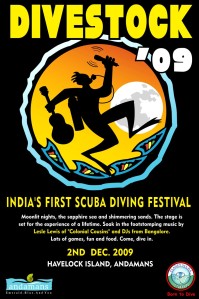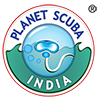 That’s right, it is here. The hottest new ” must be seen” event in India. Divestock 2009!! Made by and made for scuba divers and everyone else who loves a good party. Its inaugration will be held in Port Blair and in Havelock in the Andaman Islands.
That’s right, it is here. The hottest new ” must be seen” event in India. Divestock 2009!! Made by and made for scuba divers and everyone else who loves a good party. Its inaugration will be held in Port Blair and in Havelock in the Andaman Islands.
You know you want to be there. you know you have to be there. THIS IS THE PARTY you have been waiting for!
Nethrani Dive Trip 2009
Bangalore Dive Club together with Planet Scuba India has once again managed to take dive trips to a whole new level. The Nethrani dive trip saw a unprecendented 40 divers from India descending on Murdeshwar’s shores. It was a huge number of people and it was a show of strength from the divers.
Nethrani was closed to diving after an incident involving the arrest of some divers. This happened post 26/11 when security was a knee jerk reaction to the terror incident in Mumbai. After numerous efforts by PSI and the local diving community, Nethrani finally got approved for scuba diving.
Divers were all in high spirits waiting to begin their adventure in these “forbidden” waters as such. There was a high level of camaraderie and anticipation in the air. Even though visibility on the first day was poor due to heavy rains the night before the marine life underwater more than made up for it. Huge lobsters, cuttlefish, moray eels and many more varieties of fish kept the divers completely entertained. It truly was a fantastic dive experience.
There were press involved in this dive trip as well. They got a taste of what scuba diving is all about. The one thing that struck both press and divers is the extensive damage that has been done to the marine environment due to excessive fishing. There was mutual concensus that something had to be done to curb discriminatory practices of fishing and some sort of basic education needs to be imparted to the fishermen on what to fish and how to do it the right way without destroying the environment in which they too are dependent on.
All in all, it was a fantastic 3 days of diving and everyone had a good time. Here’s hoping that Nethrani becomes the diving paradise that it is in good time.
AOWD
That would be Advanced Open Water Diver to all those who aren’t initiated. What is the major difference between a OWD and AOWD you ask? I shall give you the simple answer. You get to go deeper. Almost twice as deep. As an OWD your maximum diving depth is 18 meters. As a AOWD you get to go down to 30 meters.
The thrill of going deeper to explore the deep blue is something that can’t be explained. Well it can be explained, there are many blogs and magazines that could wax lyrical at what it means to go deep. But i would place a bet that writing how it felt and actually being there is a world of difference. Anyways here’s how our AOWD class went.
We got certified as OWD students right there on the boat. The instructor then explained the next dive would be our first as AOWD dive. We dove in and learnt about PPB (Peak Performance Buoyancy) then we went on to do Boat Diving (that basically means diving off a boat) and then we went on to a rather thrilling Night Dive. If you have swam in the open ocean at night then you are about 1/10th of the way of getting how it feels. Try swimming in the dark about 15 meters below. With a torch to light your way you are mesmerized by the life around you, jelly fish that glow and seduce you, fishes you have never seen, the trance like movement of the soft corals. Just when you thought you would be swimming in the dark, you are taken by surprise at the amount of things you can see.
The next day we did the last two dives that would qualify us as AOWD. Navigation and Deep. The former was pretty straight forward, you needed to know how to use a compass and learn how to find your way around the ocean. The Deep. What can i say. It was probably the best dive ever. When you see your depth gauge point at 30, you have a moment where you disbelieve it. Then you take it in your stride and start exploring the varied and very beautiful sights that surround you. Trust me getting the AOWD is a must for any OWD. It just opens you up to so many diving areas around Andamans and around the world.
So, what are you waiting for? join us at PSI to get your OWD. Courses are running at full steam. Get started. Get diving right at your doorstep.
Do your part
24th Feb 2009 is the next PADI- Open Water Diver Course. Sign up with us now, so that your summer holidays will be a fun filled scuba diving one. But to more serious news.
One Fifth of World’s Corals Gone: Climate Change Battle to Rescue Remaining
The Status of Coral Reefs of the World: 2008, released in Washington, DC, December 2008, declares a 19 percent loss of coral reefs worldwide.
Launched by the Global Coral Reef Monitoring Network (GCRMN), the report identifies which coral reefs are recovering and which are declining worldwide. The report states if current trends in carbon dioxide emissions continue, many remaining reefs may be lost over the next 20 to 40 years with alarming consequences.
Project AWARE Foundation, partner behind the project and supporter of the launch event, is encouraged by the report that 45 percent of the world’s reefs are currently healthy. But the Foundation also recognizes a focus on climate change, now considered the leading threat to coral reefs today. Threats including increasing ocean temperatures and ocean acidification are intensified by other threats including overfishing, pollution and invasive species.
“If nothing changes, we are looking at a doubling of atmospheric carbon dioxide in less than 50 years,” says Carl Gustaf Lundin, Head of the IUCN Global Marine Programme, one of the organizations behind the Global Coral Reef Monitoring Network. “As this carbon is absorbed, the oceans will become more acidic, which is seriously damaging a wide range of marine life from corals to plankton communities and from lobsters to seagrasses.”
Hope is also found in the ability of some corals to recover after major bleaching events, caused by warming waters, adapting to climate change threats. However, the report also shows the recent downward trends have not been reversed in the last four years. And corals have a higher chance of survival against climate change if other human threats are minimized.
“The report details the strong scientific consensus that climate change must be limited to the absolute minimum. If nothing is done to substantially cut emissions, we could effectively lose coral reefs as we know them, with major coral extinctions,” says Clive Wilkinson, Coordinator of the Global Coral Reef Monitoring Network.
“Ten years after the world’s biggest coral bleaching event, we know that reefs can recover given the chance. Unfortunately, impacts on the scale of 1998 will reoccur in the near future, and there’s no time to lose if we want to give reefs and people a chance to suffer as little as possible,” says Dr David Obura, Chair of the IUCN Climate Change and Coral Reefs working group and Director of the Coastal Oceans Research and Development in the Indian Ocean Programme (CORDIO) in East Africa.
The GCRMN is a network of people, governments, institutes and NGOs in more than 80 countries, with many partners, including: CORDIO, Reef Check, CARICOMP, Project AWARE Foundation and AGRRA. All reports are available through www.ReefBase.org. To read more of such articles visit ProjectAware
